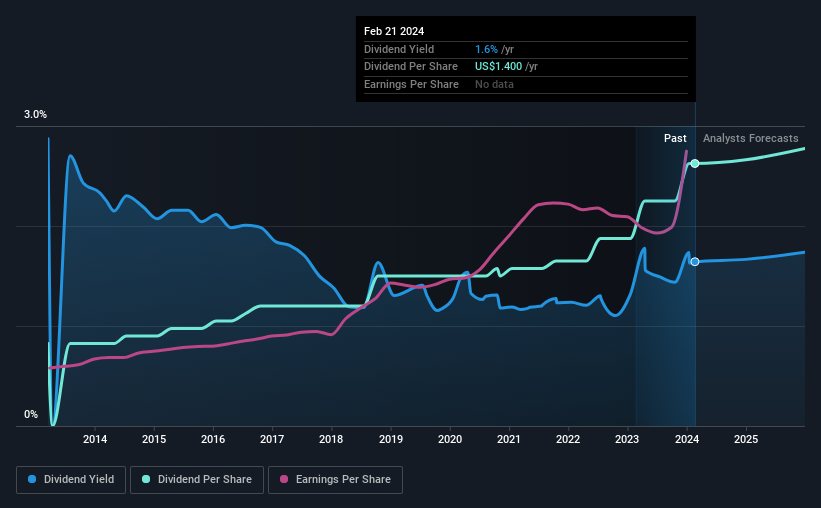The board of Bank First Corporation (NASDAQ:BFC) has announced that it will be paying its dividend of $0.35 on the 10th of April, an increased payment from last year's comparable dividend. Even though the dividend went up, the yield is still quite low at only 1.6%.
See our latest analysis for Bank First
Bank First's Dividend Forecasted To Be Well Covered By Earnings
It would be nice for the yield to be higher, but we should also check if higher levels of dividend payment would be sustainable.
Having distributed dividends for at least 10 years, Bank First has a long history of paying out a part of its earnings to shareholders. While past records don't necessarily translate into future results, the company's payout ratio of 16% also shows that Bank First is able to comfortably pay dividends.
EPS is set to fall by 27.9% over the next 3 years. Fortunately, analysts forecast the future payout ratio to be 25% over the same time horizon, which is in the range that makes us comfortable with the sustainability of the dividend.

Dividend Volatility
Although the company has a long dividend history, it has been cut at least once in the last 10 years. The annual payment during the last 10 years was $0.44 in 2014, and the most recent fiscal year payment was $1.40. This works out to be a compound annual growth rate (CAGR) of approximately 12% a year over that time. Despite the rapid growth in the dividend over the past number of years, we have seen the payments go down the past as well, so that makes us cautious.
The Dividend Looks Likely To Grow
With a relatively unstable dividend, it's even more important to evaluate if earnings per share is growing, which could point to a growing dividend in the future. Bank First has seen EPS rising for the last five years, at 14% per annum. A low payout ratio and decent growth suggests that the company is reinvesting well, and it also has plenty of room to increase the dividend over time.
An additional note is that the company has been raising capital by issuing stock equal to 15% of shares outstanding in the last 12 months. Regularly doing this can be detrimental - it's hard to grow dividends per share when new shares are regularly being created.
We Really Like Bank First's Dividend
Overall, a dividend increase is always good, and we think that Bank First is a strong income stock thanks to its track record and growing earnings. The earnings easily cover the company's distributions, and the company is generating plenty of cash. We should point out that the earnings are expected to fall over the next 12 months, which won't be a problem if this doesn't become a trend, but could cause some turbulence in the next year. Taking this all into consideration, this looks like it could be a good dividend opportunity.
Market movements attest to how highly valued a consistent dividend policy is compared to one which is more unpredictable. Still, investors need to consider a host of other factors, apart from dividend payments, when analysing a company. Case in point: We've spotted 3 warning signs for Bank First (of which 1 is a bit concerning!) you should know about. Is Bank First not quite the opportunity you were looking for? Why not check out our selection of top dividend stocks.
Valuation is complex, but we're here to simplify it.
Discover if Bank First might be undervalued or overvalued with our detailed analysis, featuring fair value estimates, potential risks, dividends, insider trades, and its financial condition.
Access Free AnalysisHave feedback on this article? Concerned about the content? Get in touch with us directly. Alternatively, email editorial-team (at) simplywallst.com.
This article by Simply Wall St is general in nature. We provide commentary based on historical data and analyst forecasts only using an unbiased methodology and our articles are not intended to be financial advice. It does not constitute a recommendation to buy or sell any stock, and does not take account of your objectives, or your financial situation. We aim to bring you long-term focused analysis driven by fundamental data. Note that our analysis may not factor in the latest price-sensitive company announcements or qualitative material. Simply Wall St has no position in any stocks mentioned.
About NasdaqCM:BFC
Flawless balance sheet with high growth potential and pays a dividend.
Market Insights
Community Narratives



